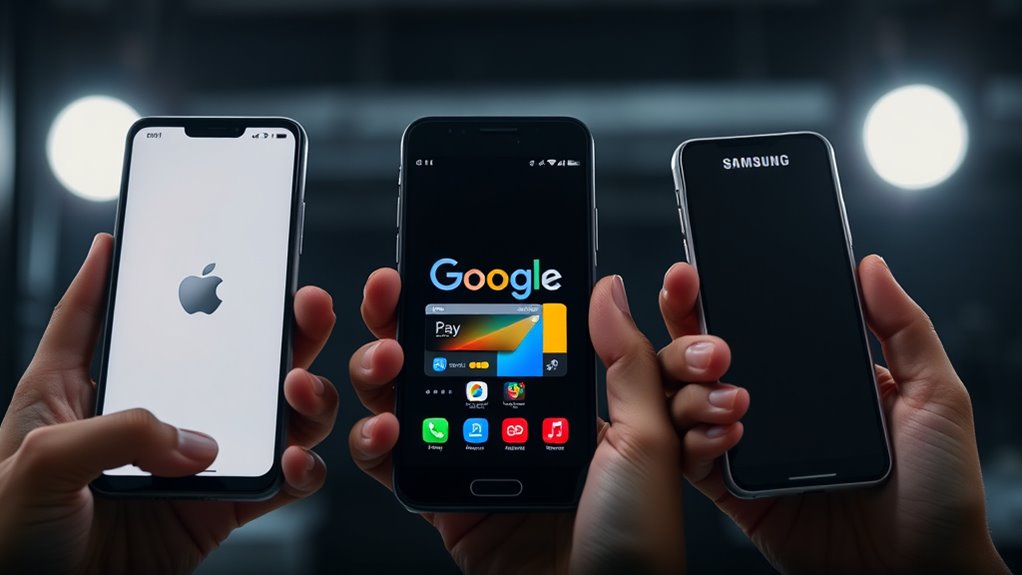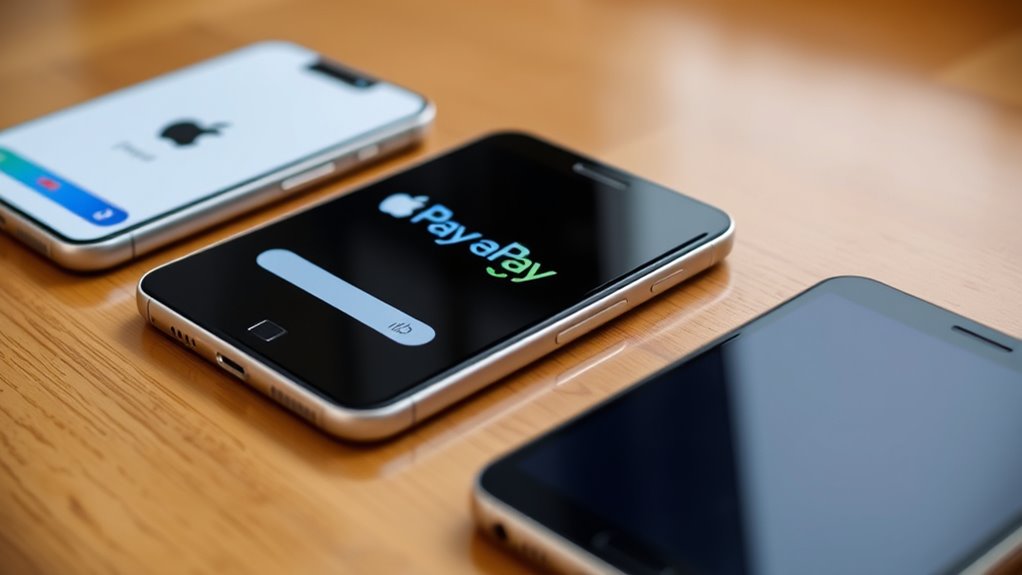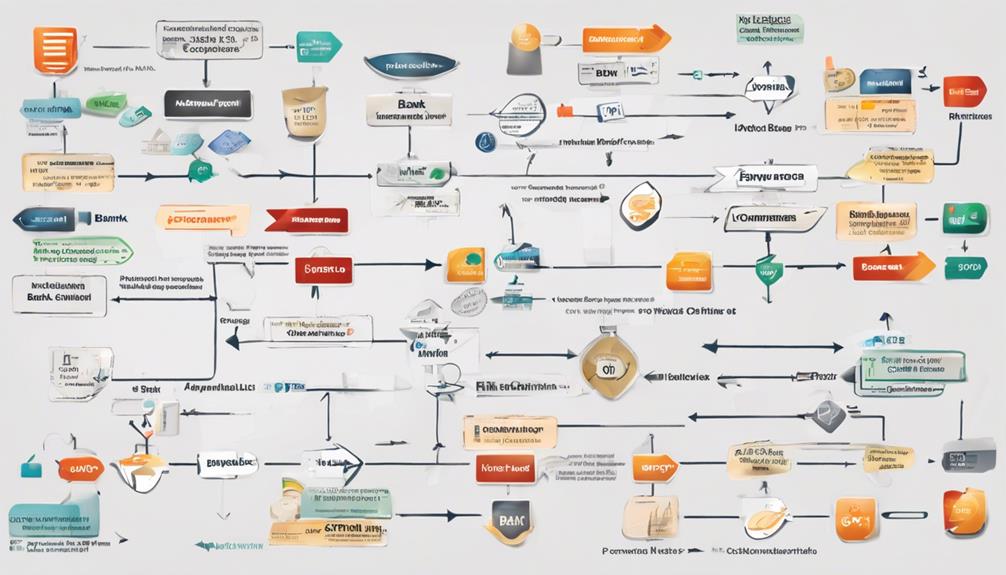Apple Pay leads with the largest user base and global reach, supporting only Apple devices and offering quick, secure contactless payments using biometrics. Google Pay, compatible with most Android devices, supports sharing tickets and files, while Samsung Pay works mainly with Samsung phones and can use MST for older terminals. Each platform emphasizes security, but their features and device compatibility differ. Keep exploring to discover more details about how these tech giants compete in mobile payments.
Key Takeaways
- Apple Pay dominates globally with over 744 million users, primarily on Apple devices, holding around 54-60% of mobile wallet transactions.
- Google Wallet has a smaller user base of 200-250 million, supporting Android devices and offering features like sharing tickets.
- Samsung Pay is regionally limited with 16.3 million users, supporting MST for compatibility with older magnetic stripe terminals.
- Apple Pay uses Face ID and Touch ID for security, while Google Wallet and Samsung Pay leverage biometric and PIN authentication.
- Device ecosystem impacts service availability: Apple Pay is exclusive to Apple devices, Google Pay supports Android, and Samsung Pay is tailored for Samsung hardware.

In the rapidly evolving world of mobile payments, Apple Pay, Google Wallet, and Samsung Pay stand out as the leading contenders vying for dominance. Each platform aims to offer seamless, secure transactions, but they differ notably in reach, device compatibility, and features. Apple Pay leads with its extensive global presence, operating in over 90 countries as of 2025. Its wide availability gives you access to a vast network of merchants and services worldwide. With approximately 744 million users globally, Apple Pay holds a substantial lead over Google Wallet, which has around 200-250 million users, and Samsung Pay, with roughly 16.3 million in the U.S. alone. In the United States, Apple Pay commands about 61.3 million users, far surpassing Google Wallet’s 48.6 million and Samsung Pay’s 16.3 million. This dominance is reflected in its market share for in-store mobile wallet transactions, where Apple Pay holds roughly 54% to 60%, compared to Google Wallet’s estimated 10%. Samsung Pay’s market penetration remains more regional and limited, mainly focusing on Samsung device owners.
Apple Pay dominates globally with over 90 countries and roughly 744 million users, leading in market share and transaction volume.
Your device ecosystem heavily influences which service you can use. Apple Pay is exclusive to Apple’s devices, including iPhones, Apple Watches, and Macs, offering tight integration that enhances security and convenience. If you own these devices, you can enjoy quick, contactless payments with just a tap. Google Wallet supports most Android devices and Wear OS smartwatches, making it more versatile across different hardware. It also facilitates features like sharing tickets and files, giving you added flexibility. Samsung Pay primarily targets Samsung devices, such as Galaxy phones and watches, and integrates seamlessly into Samsung’s ecosystem. It’s unique in supporting MST (Magnetic Secure Transmission), allowing compatibility with older payment terminals that only accept swipe cards—an advantage if you frequently encounter such machines. Additionally, advancements in security protocols across all three platforms further bolster user confidence in mobile payments.
Security is a top concern across all platforms. Apple Pay uses biometric authentication like Face ID and Touch ID to add extra security layers before approving transactions. Google Wallet supports biometric and PIN authentication, leveraging Android’s security features. Samsung Pay combines Samsung Knox security with biometric options such as fingerprint and iris scans, creating multiple barriers against unauthorized access. All three services rely on tokenization, replacing your sensitive card details with unique tokens during transactions, reducing the risk of data theft. They also utilize secure storage methods, like secure elements or Host Card Emulation (HCE), to keep your payment information protected.
Frequently Asked Questions
Are There Any Fees Associated With Using These Payment Services?
You won’t face any fees when using Apple Pay, Google Pay, or Samsung Pay for everyday transactions like shopping or online payments. Merchants pay standard processing fees, but these services don’t charge you extra. However, if you choose instant transfers to your bank account, you may encounter a small fee, especially for Google Pay and Apple Pay. Peer-to-peer transfers are generally free with debit cards across Google Pay and Samsung Pay.
Can These Services Be Used Internationally Without Restrictions?
When considering international use, you’ll find these services offer a pretty smooth experience, but a few gentle nuances might arise. You can typically use them abroad, yet acceptance depends on local merchants and your bank’s policies. Make sure your cards support contactless payments, and notify your bank before traveling to avoid any hiccups. Currency exchange and fees are managed by your bank, so check those details beforehand for a seamless journey.
What Security Measures Do These Platforms Employ to Protect Users?
You want to know how these platforms protect your payment info. They use strong security measures like tokenization, which replaces your card details with unique device-specific tokens, so your actual card info stays private. All encrypt your data during transmission, and biometric authentication adds a layer of security. Plus, remote lock and wipe options help you control access if your device gets lost or stolen.
How Do These Payment Options Compare in Terms of Transaction Speed?
Think of your payment as a race, where speed depends on your start and the track. All three options—Apple Pay, Google Pay, and Samsung Pay—use NFC, making your transaction lightning-fast, often just a few seconds. Samsung Pay’s MST can work on older terminals, sometimes adding a tiny delay. Overall, they’re all swift, with minimal lag, ensuring your payment crosses the finish line quickly and smoothly.
Are There Any Device Compatibility Limitations for Each Service?
You need to know that each payment service has device compatibility limits. Apple Pay works only with specific Apple devices like iPhone 6 or newer, requiring the latest iOS updates. Google Pay supports Android phones with NFC and Lollipop 5.0 or above, but iOS support is limited. Samsung Pay is exclusive to select Samsung Galaxy smartphones and smartwatches, needing Samsung Knox security. All three depend on NFC hardware and recent OS versions for proper use.
Conclusion
As you navigate the world of mobile payments, one thing’s clear: the battle among Apple Pay, Google Pay, and Samsung Pay isn’t over. Each offers unique strengths, but the true winner might still be lurking just around the corner. Will a new contender shake up the scene or will one of these giants solidify its dominance? Keep watching — the next move could change everything, and you won’t want to miss what’s coming next.









